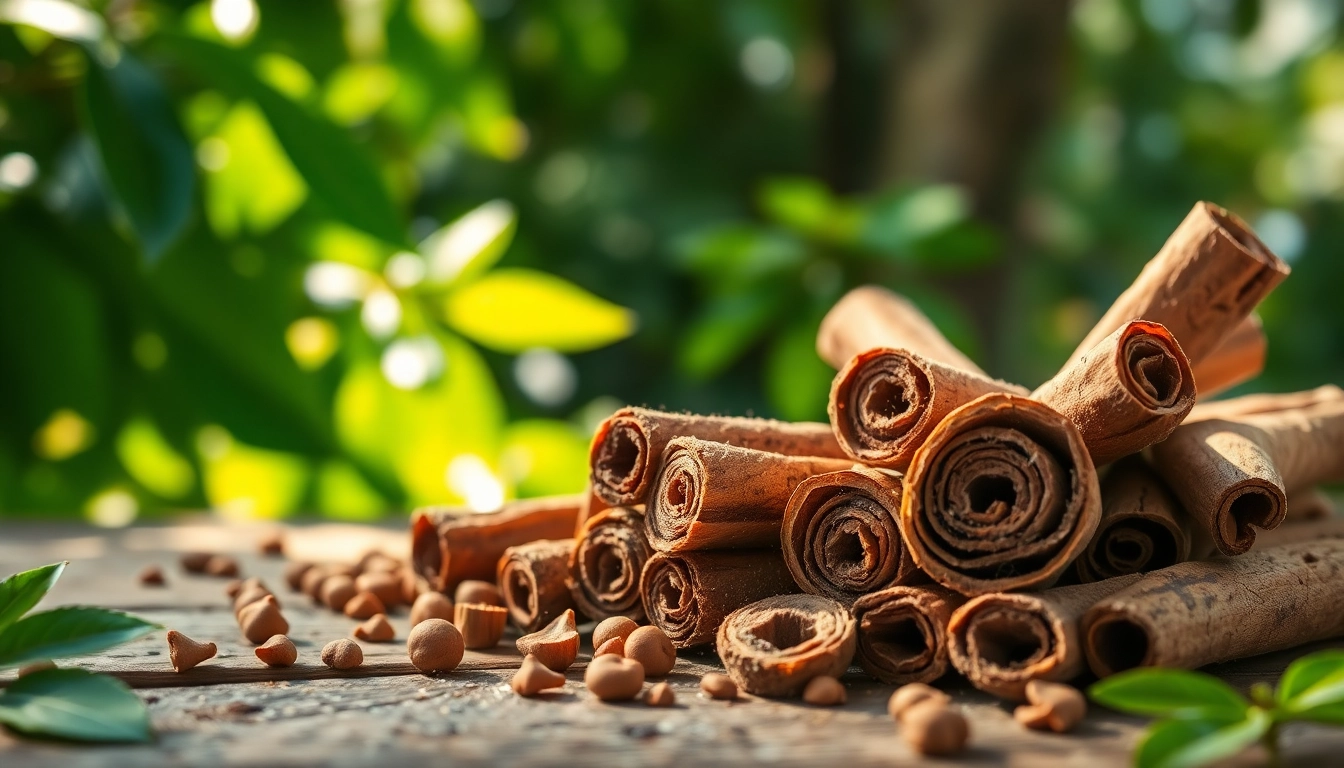
Understanding Cinnamon Bark
What is Cinnamon Bark?
Cinnamon bark is derived from the inner bark of trees belonging to the genus Cinnamomum, which includes over 250 species, primarily found in tropical regions. This aromatic spice is renowned for its distinct flavor and scent, making it a common ingredient in both culinary and medicinal applications across various cultures. It often appears in both ground and stick forms, with the sticks providing a traditional approach to infusing dishes with flavor. A lesser-known fact is that Cinnamon Bark is not exclusive to kitchens; it has deep roots in ancient medicine, owing to its impressive list of properties that benefit health.
Types of Cinnamon Bark: Ceylon vs. Cassia
Two primary types of cinnamon exist in the culinary world: Ceylon and Cassia. Ceylon cinnamon, sometimes referred to as “true cinnamon,” comes from Cinnamomum verum. It is often more prized due to its complex flavor profile, which is sweeter and more delicate compared to Cassia cinnamon, derived from Cinnamomum cassia. Cassia is the more common variety found in stores and contains higher levels of coumarin, a compound that can be harmful in large doses.
One key difference involves their appearance: Ceylon cinnamon has a light brown color with a soft, flaky texture, while Cassia cinnamon is darker, thicker, and harder, with a more intense flavor. When choosing between the two, consider the specific flavor notes desired for your culinary applications and potential health implications, particularly if you intend to use it in significant quantities.
Historical Significance of Cinnamon Bark in Cultures
Cinnamon has been treasured for thousands of years. Ancient Egyptians used it in embalming practices, while in ancient China, it was utilized as a spice and a remedy, mentioned in texts dating back to around 2700 BC. The Romans recognized its value for flavoring, purchasing it at high costs as it was associated with nobility and wealth.
During the Middle Ages, cinnamon was a coveted item in Europe, traded extensively and even used as currency. Spices like cinnamon played significant roles in historical trade routes, with demand leading to exploration and the eventual discovery of new lands. Today, cinnamon continues to be integrated into various cultures, from traditional Indian cuisine to Western holiday recipes, embodying a rich history of culinary and medicinal use.
Health Benefits of Cinnamon Bark
Potential Health Advantages of Using Cinnamon Bark
Cinnamon bark has garnered attention for its numerous health benefits, substantiated by both traditional use and modern scientific investigation. Research indicates that it may help in managing blood sugar levels, which is particularly beneficial for those with Type 2 diabetes. The active components in cinnamon, such as polyphenols, exhibit insulin-like activity and improve insulin sensitivity, facilitating glucose metabolism.
Additionally, cinnamon has demonstrated antioxidant properties, combating oxidative stress within the body. This characteristic not only plays a role in overall health but also aids in reducing inflammation, potentially lowering the risk of chronic diseases such as heart disease and cancer.
Medicinal Properties of Cinnamon Bark
More than just a culinary ingredient, cinnamon bark has profound medicinal properties. It can assist in alleviating gastrointestinal complaints, such as bloating or gas.
Moreover, cinnamon has been used traditionally to manage menstrual cramps and has shown promise in fighting various infections due to its antimicrobial properties. Its use extends to addressing colds and respiratory issues, supporting the immune system, and providing relief from stress and fatigue.
Despite its many benefits, caution is warranted, especially concerning Cassia cinnamon due to its coumarin content, which can pose health risks when consumed in excessive amounts over time.
Precautions and Side Effects of Cinnamon Bark
While cinnamon bark offers numerous health benefits, it is essential to acknowledge potential side effects. Individuals may experience allergic reactions or gastrointestinal distress from excessive consumption. Additionally, Cassia cinnamon, in particular, can lead to liver damage if taken in high doses because of its coumarin content.
Those on medication, especially blood thinners or diabetes-related drugs, should consult a healthcare professional before significantly increasing their cinnamon intake, as it may interact with these treatments. Pregnant and breastfeeding women are also advised to exercise caution and seek medical advice regarding cinnamon use.
Culinary Uses of Cinnamon Bark
How to Incorporate Cinnamon Bark into Recipes
Cinnamon bark imparts rich and warm flavor nuances to both sweet and savory dishes. In cooking, whole sticks can be added to stews, broths, or rice dishes to imbue them with a subtle cinnamon flavor while maintaining the integrity of the bark itself. Ground cinnamon can enhance baked goods, spice blends, and beverages.
A versatile ingredient, cinnamon bark can be utilized in teas, used to flavor hot beverages like hot chocolate, or blended into smoothies. Chefs appreciate its ability to bridge flavor gaps in recipes, pairing beautifully with both fruits and nuts.
Cinnamon Bark in Traditional Dishes Around the World
Cinnamon holds a significant place in various culinary traditions around the globe. In Middle Eastern cuisines, it is a key component in spice mixes and is often added to savory dishes like tagines for a warm kick. Indian curries frequently combine cinnamon with other spices to create complex flavor profiles, while in Western cultures, it is famously featured in desserts such as apple pie, cakes, and pastries.
In Southeast Asia, cinnamon is often included in marinades and curries, contributing to the characteristic flavors of the region’s dishes. The diversity of cinnamon’s applications underscores its universal appeal and versatility in enhancing culinary experiences.
Pairing Flavors: What Goes Well with Cinnamon Bark?
Pairing cinnamon bark with complementary flavors enhances its natural taste and depth. Common pairings include spices like nutmeg, cloves, and cardamom, which create aromatic blends frequently used in festive recipes. Fruits like apples, pears, and bananas harmonize with cinnamon’s sweetness, making them ideal for pies and crumbles.
Additionally, nuts such as walnuts and pecans match well with cinnamon, often appearing together in baked goods or granola mixes. Other complementary flavors include vanilla, cocoa, and honey, making cinnamon a staple in various dessert recipes.
Buying and Storing Cinnamon Bark
Choosing Quality Cinnamon Bark: Tips and Tricks
When purchasing cinnamon bark, opt for reputable sources that offer high-quality products. Look for Ceylon cinnamon if you want the more aromatic and less coumarin-rich variety, while Cassia may be more budget-friendly if purchasing in bulk. The freshest cinnamon bark should have a rich aroma and a flexible texture, indicating it hasn’t been overly dried out.
It may also help to check labels and ensure that the product is sourced sustainably, as responsible sourcing practices can significantly influence flavor and quality. Furthermore, sift through reviews and certifications to gauge reliability before making a purchase.
Proper Storage Methods for Cinnamon Bark
To maintain the freshness and flavor of cinnamon bark, proper storage is critical. Store it in an airtight container in a cool, dark place, preferably a pantry, away from direct sunlight and moisture, which can compromise its flavor over time.
While whole cinnamon sticks last longer and maintain their flavor better than powdered cinnamon, ground varieties should be used within six months to a year. Keeping cinnamon away from heat sources and strong-smelling spices can help maintain its aromatic profile.
Understanding Cinnamon Bark Pricing and Sourcing
The pricing of cinnamon bark can vary widely depending on factors like the type, quality, and source. Ceylon cinnamon typically costs more than Cassia due to its more labor-intensive harvesting and lower availability. When looking into sourcing, consider sourcing from suppliers that prioritize ethical practices and quality over mere affordability to ensure you receive a product that aligns with your culinary and health goals.
Emerging trends point to increasing consumer demand for Ceylon cinnamon, which can lead to price fluctuations and availability challenges. Staying informed about market trends helps consumers make educated purchasing decisions.
Exploring the Future of Cinnamon Bark
Research Trends and Innovations in Cinnamon Bark Uses
The future of cinnamon bark encompasses ongoing research that explores its potential applications in various fields, including nutrition and medicine. Recent studies underscore its antioxidant properties, anti-inflammatory effects, and benefits in stabilizing blood sugar levels, assisting in developing functional foods and therapeutic products.
Innovations in extraction methods also pave the way for more concentrated forms of cinnamon, potentially enhancing its health benefits while improving flavor retention in processed foods and herbal supplements. As interest in natural and plant-based ingredients grows, the scope of cinnamon’s application will likely expand.
The Importance of Sustainable Sourcing of Cinnamon Bark
As demand for cinnamon continues to rise, it’s increasingly critical to focus on sustainable sourcing practices. Deforestation, unethical harvesting, and environmental devastation are prominent issues affecting cinnamon-producing regions. Sustainable farming methods help mitigate these problems while ensuring high-quality product availability for consumers.
Consumers can actively support sustainability by purchasing products from companies that practice responsible sourcing. Transparent companies often provide insights into their supply chain and sourcing methods, enabling consumers to make informed choices that reflect their values.
Consumer Demand and Market Trends for Cinnamon Bark
Recent market analyses indicate a significant rise in consumer demand for natural spices like cinnamon, driven by increased awareness of health benefits and interest in holistic wellness. Demand for Ceylon cinnamon has notably surged, often associated with its perceived higher quality and numerous health advantages compared to the more commonly available Cassia variety.
With the growing interest in natural and organic products, cinnamon’s prominence in the wellness market extends beyond culinary uses, entering realms of supplements and health products. Industries that incorporate cinnamon into their offerings are more likely to resonate with health-conscious consumers, showcasing the spice’s multidimensional appeal.








